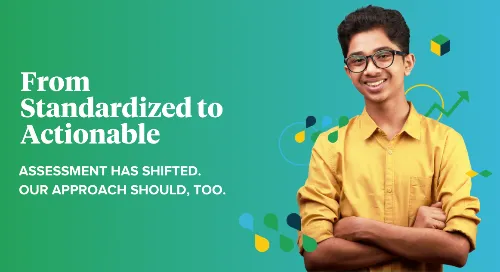BREAKING: Assessments, historically administered to identify how much learning has been retained within a given year, have now shifted to provide actionable data that informs learning.
Sound familiar?
We’ve all witnessed and heard about the shift in the K-12 assessment landscape over the last two years. Although it may feel like the pandemic was the root cause, we like to see it as the catalyst for a transformation that started long before 2020.
Why Has Assessment Shifted?
For too long, educators have had to rely on state testing data to gauge their students’ knowledge. The problem? That data is only available to teachers when it’s too late to inform instruction and actually improve student outcomes. Additionally, high-stakes assessments place a heavy burden on teachers to prepare their students for the length and breadth of these state tests, disrupting everyday learning and putting unnecessary stress on teachers and students alike. It’s time to move towards a balanced assessment approach that’s part of the regular instructional cycle.
How Did We Get Here?
Here’s a quick recap of how the conversation around assessment has changed since the pandemic began.
2020: When state assessments were canceled in 2020 and districts were left to their own devices to measure and address learning needs, teachers, district administrators, and state leaders alike were forced to ask the question: Is there a better way to gauge what students know throughout the year? During remote learning, 76% of educators delivered formative assessments to check students’ understanding.
2021: Though students continued to feel pressure around high-stakes tests, their perceived value decreased dramatically, according to a previous study in which Instructure surveyed K-12 educators and parents in the United States. In terms of measuring student success, respondents perceive traditional standardized test scores as the least important among fourteen factors, at only 29%.
2022: Our most recent survey revealed that although 93% of respondents (teachers and administrators) administer state assessments, only 55% positively perceive them as they continue to make both teachers and students anxious.
The Path Forward
Last year, I shared a few considerations for educators to keep in mind as they prepared for the future of assessment. But now, the future is here and it’s student-centered. Ready to join the revolution? Here a few tips to get started:
Reframe assessments: They are part of the learning process.
Accountability testing exists to ensure every student receives a high-quality education. However, its standardized approach has made it difficult for teachers (as shown in the quote below) to understand and address learning needs in the moment, and adjust instruction to improve student outcomes.
"Summative assessments are extremely stressful for both students and teachers. The data given is not helpful for daily instruction." - State of K-12 Assessment survey respondent
Moving forward, we need to lessen our reliance on high-stakes tests and instead take a more balanced approach to assessment. Work with the stakeholders in your school—parents, teachers, administrators, and students—to find common ground and reframe the meaning of assessment so it can be used to fuel teaching and learning. This change in mindset allows us to focus on assessment as a tool that helps identify learning opportunities rather than a reflection of learning outcomes or achievement.
Balance your approach: There’s more than one way to measure learning.
A balanced assessment approach should include multiple measures that provide actionable, timely, and meaningful data that can validate where learning is happening.
Before you assess, first identify your objective. Is it to better understand individual student needs and improvement areas? To inform classroom instruction as a whole? To evaluate understanding of material across a class or grade? Your objective should help to determine the best assessment approach.
Shift your mindset: Assessment is for learning, not achievement.
Nearly two thirds (60%) of our respondents say that assessment should measure student growth rather than reflect achievement.
“Assessments provide clarity in learning for teachers and students. It drives the feedback cycle.” -State of K-12 Assessment survey respondent
Assessments become stressful when we emphasize how the results will impact a student’s grade rather than focusing on the opportunity to help students learn. All too often, teachers and students view assessments as the finish line, the culmination of a unit or even a school year. When in reality, learning spans grade levels and years, and assessments should be seen as stepping stones that help students build upon their knowledge.
Learning is a journey, not a destination.
Keep learning,
Trenton Goble, VP of K12 Strategy at Instructure
Download the Report
Get more insights from our State of K-12 Assessment. Download the report here.
Related Content
 inst-3step.jpg
inst-3step.jpgBlogs
 digging_deep_into_2025s_learning_trends_the_state_of_higher_education_in_anz_-_thumbnail_1.png
digging_deep_into_2025s_learning_trends_the_state_of_higher_education_in_anz_-_thumbnail_1.pngBlogs
 13lmsfeaturesthatbenefitstudentlearning.jpg
13lmsfeaturesthatbenefitstudentlearning.jpgBlogs

